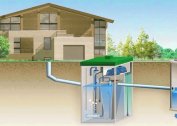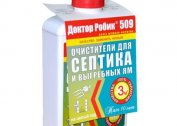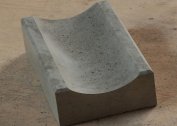The duration of its operation and the uninterrupted functioning of operation depend on the correctly selected depth of immersion of the sewage system in the soil. The most serious test for the system is the cold season, as well as the spring-autumn periods when groundwater rises, there is little snow, and unexpected frost can cause damage to the system. If the pipe laying depth is insufficient, they can freeze, which will damage the sewer system. Another hazard is external mechanical stress. With a trench depth of less than 50 cm, when the pipes pass under a pedestrian path or a section along which cars drive, they can become deformed, leak, and the sewage system will fail.
On the other hand, with excessive deepening of the sewage system, the soil layer itself can exert an excessive load. This can lead to cracks in the system, especially when using plastic pipes that are less durable than cast iron. To prevent this from happening, it is important not only to correctly calculate the optimal pipe instillation depth, but also to choose the pipes themselves correctly. Ductile iron pipes are durable, but today they are used less and less. They were replaced by lighter and cheaper plastic ones. They are of two types: gray for domestic sewage and orange for outdoor. Orange is made from a durable material - unplasticized polyvinyl chloride. They have a thick wall - 3.2 - 3.4 mm, they have higher heat resistance and durability.
Depth standards and what affects them
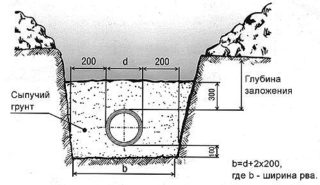 The rules for arranging sewage are determined by SNiP 3.05.04-85. A clear requirement for the depth of sewerage is not specified in the documents. This is due to the fact that climatic conditions and soils in different regions of the country are different. The minimum level of sewerage deepening is calculated by subtracting 30 cm from the value called “soil freezing depth” (for pipes with a diameter of up to 40 cm). In each region, this level is different. The stronger the frosts in a particular area, the deeper the trench for the sewer pipeline should be. It has been experimentally determined that less than 70 cm deepening is dangerous.
The rules for arranging sewage are determined by SNiP 3.05.04-85. A clear requirement for the depth of sewerage is not specified in the documents. This is due to the fact that climatic conditions and soils in different regions of the country are different. The minimum level of sewerage deepening is calculated by subtracting 30 cm from the value called “soil freezing depth” (for pipes with a diameter of up to 40 cm). In each region, this level is different. The stronger the frosts in a particular area, the deeper the trench for the sewer pipeline should be. It has been experimentally determined that less than 70 cm deepening is dangerous.
The output of the intra-house sewage system should be located 0.3 m above the freezing depth of the soil, because the wastewater is quite warm at the exit from the house. Then cooling drains are protected from freezing by a layer of soil.
The deeper the sewage is laid, the closer it is to groundwater. With a seasonal increase in their level, the sewage system may be in the water. With a sharp drop in temperature, it can freeze, and go out of order. To avoid this, it is necessary to insulate the sewer system.
Protect the sewer from freezing can:
- Heating cables.
- Pipe insulation (shell made of polystyrene foam or expanded polystyrene, basalt cotton wool, foamed polyethylene).
Sewer pipes are laid at a slope so that domestic waste water flows by gravity. Therefore, in a flat area, the depth of the trench must increase to create the desired slope. The slope depends on the diameter of the pipes:
- Ø = 5 cm - 3 cm per 1 m of length;
- Ø = 11 cm - 2 cm per 1 m of length;
- Ø = 15 cm - 8 mm per 1 m of length;
- Ø = 20 cm - 7 mm per 1 m of length.
If these parameters are not taken into account, it is possible either siltation of pipes due to the slow movement of the flow, or blockages due to the fact that too rapid a flow of water does not have time to wash off solid particles from the internal walls. Therefore, the maximum slope is strictly regulated - 15 cm per 1 m of pipe. SNiP recommend a fluid flow rate in sewer pipes of 0.7 - 1.0 m / s. This speed is provided by the recommended normative documents tilt angles for different pipe diameters.
Important factors for the calculation are the topography and soil structure.
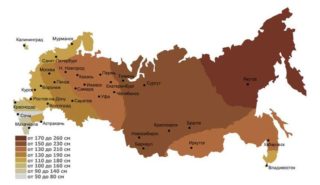 There is a "Map of the depth of freezing of the soil." Depending on the region and soil structure, the depth of the sewage system will vary.
There is a "Map of the depth of freezing of the soil." Depending on the region and soil structure, the depth of the sewage system will vary.
The formula for determining the depth of soil freezing according to SNiP 2.02.01-83 is h = √ M * k, where M * is the sum of the absolute average monthly temperatures (in winter) in a certain region, k is the coefficient for each soil type:
- clay and loam - 0.23;
- sandy loam, fine and silty sands - 0.28;
- large, medium and gravelly sands - 0.3;
- coarse soil - 0.34.
With the advent of new technologies, cesspools are a thing of the past. Today, septic tanks are most often used, the depth of the burial of which depends on their model. In any case, it is at least 1.5 m.
To calculate the depth of the trench at the point of connection of the pipeline to the tank with wastewater, the formula is used: H2 = H1 + L × k, where:
- H2 - depth of connection to the well;
- Н1 - sewage exit level from the house;
- L is the length of the pipes;
- k - slope coefficient (0.03 for pipes Ø 5 cm, 0.02 for pipes Ø 10 - 11 cm, 0.01 - for larger diameter).
If for L we take the length of the pipes to the desired section, we can calculate the depth of the trench on any section of the drainage system.
Thus, in order to calculate the depth of laying the sewer pipe in a private house, you need the sum of the absolute average monthly temperatures in the region of interest and the nature of the soil on the site. After calculating the depth of freezing of the soil, you need to subtract 30 cm from this figure. This will be the depth of the trench. In any case, it can not be less than 70 cm.
Calculation example
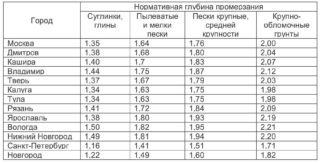 Today, there are calculators for calculating the depth of soil freezing, depending on the region and soil type. This is the fastest and easiest way to calculate. You can independently find out in the meteorological service the average monthly winter temperatures in the region and, knowing the soil of your site, calculate the depth of freezing of the soil on your site.
Today, there are calculators for calculating the depth of soil freezing, depending on the region and soil type. This is the fastest and easiest way to calculate. You can independently find out in the meteorological service the average monthly winter temperatures in the region and, knowing the soil of your site, calculate the depth of freezing of the soil on your site.
For example, in Nizhny Novgorod, on a site with loamy soil, the depth of soil freezing is 1.447 m. Subtracting 0.3 m from this figure, it turns out 1.147 m. Thus, pipes with a diameter of less than 50 cm should be buried at a depth of 1.1 m.
If all these conditions are met, you can be sure of the reliability and durability of the communications made and enjoy all the benefits of civilization, enjoying life in nature, and not in the “stone jungle”.
